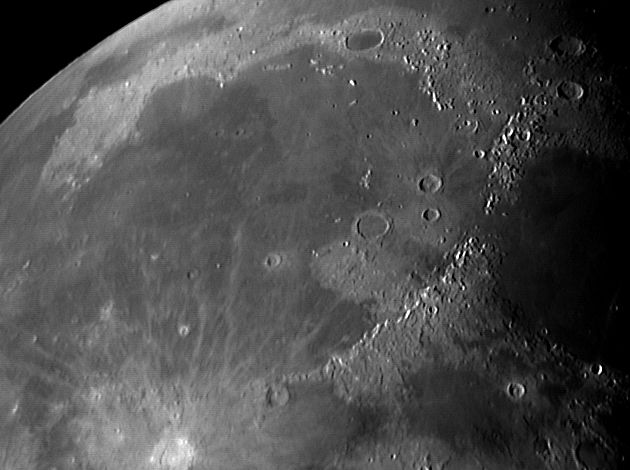

This page has improved and moved. If it does not refresh in 5 seconds, please click HERE to go to the new page.
Move your mouse over the picture to see the names of the various features. Mare Imbrium is the largest (830,000 sq Km) and one of the youngest (3,800 million years)
impact basins on the Moon. Such impact basins are characterised by one or more concentric
rings of mountains of which frequently only the outer one remains clearly visible.
In the case or this Mare, the ring consists of the Carpathian mountains, in the south,
the Apennines, the Alps, and finally the Jura in the north. It is uncertain whether the
Caucasus mountains are a part of this circle or not. For some reason there is a break
in the circle in the south-west where the lavas from Oceanus Procellarum merge with those
of the Mare Imbrium. The original ring has been degraded by later impacts,
for example Sinus Iridum which must have been formed after the formation of Imbrium itself,
but before the basin was flooded with lava maybe about 3,200 million years ago.

This picture was taken using a ToUcam, and a 0.33 focal reducer on my LX200 to get the wide-angle view. It was taken using an infra-red pass filter (>635nm). The scale markers are approximately 200 Km north and east and apply in the region of Archimedes. However, both the scale and the directions will be different in different parts of a
picture covering such a large area.
The picture was taken with a ToUcam attached to my LX200 on 23rd September 2005 at 03:22 UT,
when the Moon was 20.1 days old.
Date and Time
23rd September 2005 at 03:22 UT
Camera
ToUcam 740K
Telescope
LX200 with 0.33 focal reducer and IR-pass filter
Capture
K3CCDTools. Low gamma, 1/33", 22% gain, 380 frames
Processing
Registax. 116 frames stacked. Wavelet 1 = 10, gamma 0.9, histogram 15-200
Home Back to NW Quadrant